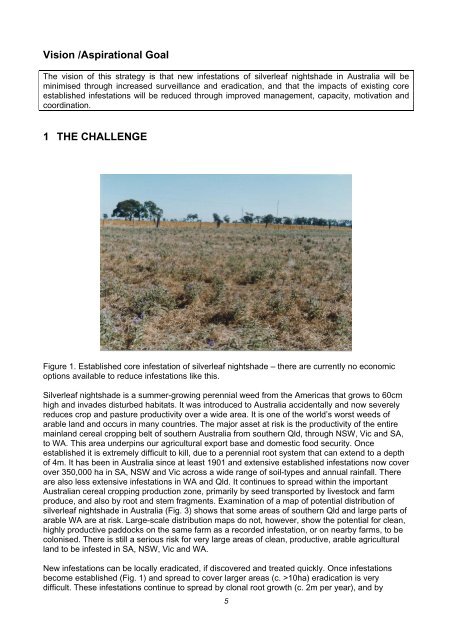EXECUTIVE SUMMARY<strong>Silverleaf</strong> <strong>nightshade</strong> (Solanum elaeagnifolium) is recognised as one of the world’s worstagricultural weeds, and has recently been included as one of 12 new <strong>Australia</strong>n <strong>Weeds</strong> of NationalSignificance (WoNS). It currently infests over 350,000 ha of productive farmland, is still spreading,and has the potential to infest almost all of the farmlands in the cereal growing regions of SA,NSW, Vic and WA. Once established, there are no practical methods available to destroy largecore infestations. It is a competitive, tenacious, drought-tolerant perennial weed that has a veryextensive and resilient root system. Once established it has a chronic and debilitating effect onproductivity, often reducing crop and pasture yields by 20 to 40%. Herbicides that are suitable foruse on crop production land give only short to medium-term control of shoots and seed set. Newshoots can re-grow quickly, nourished by the reserves of the deep root system. Cultivation,mowing and burning are ineffective, and competitive crops and pastures give only limited control.There are currently no biological control agents established in <strong>Australia</strong>, although progress hasbeen made in South Africa.This strategic plan defines a focused and coordinated national five year approach needed toprevent new infestations from occurring, find and destroy outlier infestations, and to reduce theimpact of established core infestations on the productivity of the cereal zone that underpins<strong>Australia</strong>’s agricultural production. It is founded on the seven key principles of the <strong>Australia</strong>n<strong>Weeds</strong> Strategy, and adopts the three common goals of all WoNS projects: 1) New infestations areprevented from establishing; 2) Established infestations are under strategic management, and 3)There is greater capability and commitment to manage silverleaf <strong>nightshade</strong>. The plan relies onshared responsibility and enthusiasm from a wide range of stakeholders. This can only beachieved through commitment, teamwork, consultation, involvement, awareness, capacity buildingand the formation of enduring partnerships. The plan aligns with the <strong>Australia</strong>n <strong>Weeds</strong> Strategy,and will be implemented by a national stakeholder group who will report to the <strong>Australia</strong>n <strong>Weeds</strong>Committee (AWC) using an agreed monitoring, evaluation, reporting and improvement (MERI)framework.A coordinated, national management program involving a wide range of stakeholders is proposed,using key objectives and strategic actions under the three goals:• Goal 1: New infestations are prevented from establishing. Goal one will focus on preventingnew infestations from occurring or establishing. Key propagule sources, vectors andinvasion pathways will be indentified and managed. Stakeholder awareness and vigilancewill be crucial to ensure that new and priority outlier infestations are eradicated andmonitored.• Goal 2: Established infestations are under strategic management. Goal two will improvemanagement of existing, established core infestations to protect the major agriculturalassets at risk. The emphasis will be on filling knowledge gaps, delivering best practicemanagement guides, and encouraging strategic management of infestations to improvecrop and pasture yields and reduce propagule spread. Biological control and allelopathyfrom Eucalyptus spp. will also be reviewed to identify opportunities.• Goal 3: Greater capability and commitment to manage silverleaf <strong>nightshade</strong>. Goal three willconcentrate on building enduring awareness, capacity and motivation. A key objective is toestablish a silverleaf <strong>nightshade</strong> national management group. Mapping and researchactivities will improve the effectiveness of management, and inform prioritisation. Bestmanagement practice information will be delivered through published resources andstakeholder meetings. Landholders will be motivated to control silverleaf <strong>nightshade</strong> byprovision of economic modelling and case studies, and stakeholders will be encouraged tointegrate the goals of this plan into regional and state/territory planning.4
Vision /Aspirational GoalThe vision of this strategy is that new infestations of silverleaf <strong>nightshade</strong> in <strong>Australia</strong> will beminimised through increased surveillance and eradication, and that the impacts of existing coreestablished infestations will be reduced through improved management, capacity, motivation andcoordination.1 THE CHALLENGEFigure 1. Established core infestation of silverleaf <strong>nightshade</strong> – there are currently no economicoptions available to reduce infestations like this.<strong>Silverleaf</strong> <strong>nightshade</strong> is a summer-growing perennial weed from the Americas that grows to 60cmhigh and invades disturbed habitats. It was introduced to <strong>Australia</strong> accidentally and now severelyreduces crop and pasture productivity over a wide area. It is one of the world’s worst weeds ofarable land and occurs in many countries. The major asset at risk is the productivity of the entiremainland cereal cropping belt of southern <strong>Australia</strong> from southern Qld, through NSW, Vic and SA,to WA. This area underpins our agricultural export base and domestic food security. Onceestablished it is extremely difficult to kill, due to a perennial root system that can extend to a depthof 4m. It has been in <strong>Australia</strong> since at least 1901 and extensive established infestations now coverover 350,000 ha in SA, NSW and Vic across a wide range of soil-types and annual rainfall. Thereare also less extensive infestations in WA and Qld. It continues to spread within the important<strong>Australia</strong>n cereal cropping production zone, primarily by seed transported by livestock and farmproduce, and also by root and stem fragments. Examination of a map of potential distribution ofsilverleaf <strong>nightshade</strong> in <strong>Australia</strong> (Fig. 3) shows that some areas of southern Qld and large parts ofarable WA are at risk. Large-scale distribution maps do not, however, show the potential for clean,highly productive paddocks on the same farm as a recorded infestation, or on nearby farms, to becolonised. There is still a serious risk for very large areas of clean, productive, arable agriculturalland to be infested in SA, NSW, Vic and WA.New infestations can be locally eradicated, if discovered and treated quickly. Once infestationsbecome established (Fig. 1) and spread to cover larger areas (c. >10ha) eradication is verydifficult. These infestations continue to spread by clonal root growth (c. 2m per year), and by5
















